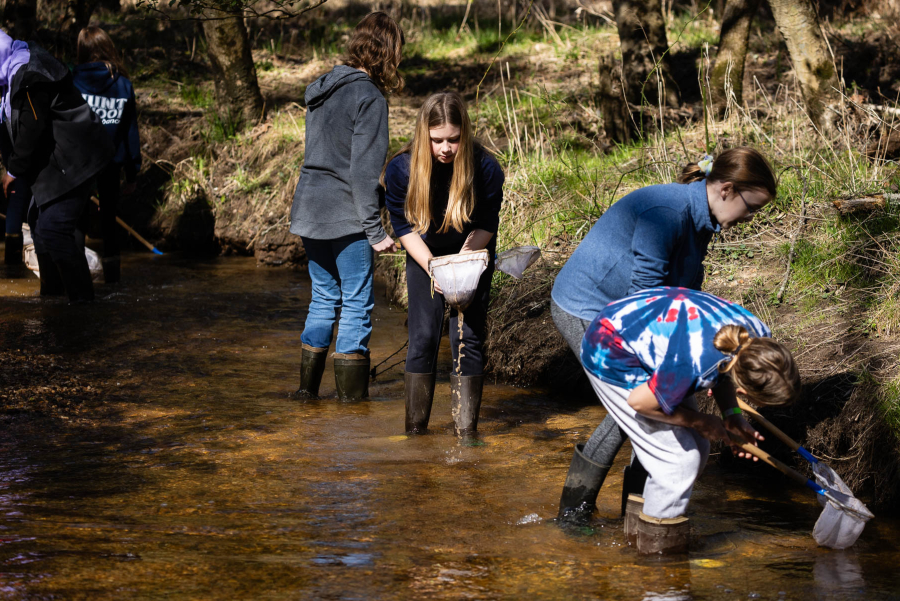The health of streams in the Chesapeake Bay watershed is improving, according to recent data
Bay Program’s Stream Health outcome saw a 6% increase

When we think of the Chesapeake Bay, it’s often the sprawling body of water that sits below the Bay Bridge, the tidal wetland or beach at our favorite park, or the grassy bottom where blue crabs crawl around. But the watershed that feeds the Bay includes hundreds of thousands of small streams flowing through our communities. These waterways, some of which are too small to have a name, can carry excess nutrients, sediments and other pollutants that ultimately end up in the Bay.
According to data released by the Chesapeake Bay Program, these streams are getting healthier as a whole, improving by 6% since a 2008 baseline.
After the signing of the most recent Chesapeake Bay Watershed Agreement in 2014, the partnership began assessing biological conditions of the watershed’s streams through its Stream Health outcome. Multiple state, federal and local partners, as well as community volunteers, wade into streams and collect water samples that give a snapshot of the macroinvertebrate life within a section of a stream. Macroinvertebrates are a good indication of a stream’s water quality because they are sensitive to pollutants and to habitat degradation.
These samples are used to calculate a stream health scoring index called the Chesapeake Basin-wide Index of Biotic Integrity, or Chessie BIBI. Accounting for natural and geographic differences in an area, the index rates the sampled stream miles as having excellent, good, fair, poor or very poor health. If the sampled area is fair, good or excellent, it’s considered healthy.
Chessie BIBI scores are assessed in six year intervals to accommodate the different sampling schedules of state monitoring programs and ensure the full watershed is being covered in each interval. So far, three intervals can be compared: 2000-2005, 2006-2011 and 2012-2017.
For 2000-2005, it was estimated that 57% of the watershed’s stream miles were healthy. That number went up to 62% for 2006-2011 and the newest dataset from 2012-2017 indicates that 68% of the watershed’s stream miles are healthy. While conditions vary from region to region, with some areas of the watershed showing degrading trends, the overall net improvement trend suggests that environmental stressors on streams may be slowly lessening in many parts of the Chesapeake watershed. These stressors include streambank erosion, nutrient runoff, temperature spikes and stream flow intensity, and more.
The caveat to this finding is that given the numerous miles of streams in the watershed, it’s difficult to monitor them all. In the latest 2012-2017 dataset, about 41.5% of the Chesapeake’s subwatersheds were not sampled. For those areas, scientists used statistical methods to estimate their health based on data that was available elsewhere in the watershed.
This update puts the Chesapeake Bay Program on track to achieve its Stream Health outcome, which is to improve upon the 61% score from 2006-2011 and increase it by 10%. In 2009, President Barack Obama’s Chesapeake Bay Executive Order called upon partners to have 70% of sampled streams throughout the watershed be in fair, good or excellent condition. That is also expected to be reached.
Credit for sampling and counting macroinvertebrates in our watershed’s streams goes to numerous entities—from federal and state agencies to counties and volunteer monitoring groups. A full list of partners involved in this work can be found on Chesapeake Progress.
Are you interested in helping to sample stream health in the Chesapeake Bay watershed? Visit the Chesapeake Monitoring Cooperative website and find a group near you to connect with!

Comments
There are no comments.
Thank you!
Your comment has been received. Before it can be published, the comment will be reviewed by our team to ensure it adheres with our rules of engagement.
Back to recent stories